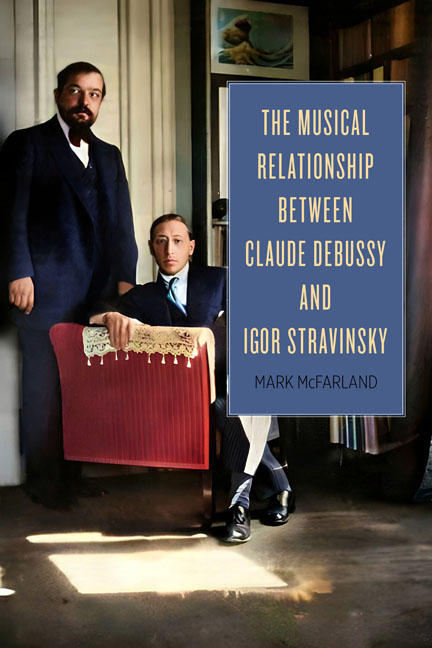Book contents
- Frontmatter
- Dedication
- Contents
- Acknowledgments
- Introduction
- 1 A Mutual Influence
- 2 Cinematic Montage and Stratified Form
- 3 Stratified Form in Debussy’s Works: 1909–1913
- 4 Debussy and the Chromatic Set
- 5 Stratified Form in Jeux
- 6 Stravinsky’s Waning Influence: 1914–1917
- Conclusion
- Glossary
- Bibliography
- Index
5 - Stratified Form in Jeux
Published online by Cambridge University Press: 10 May 2024
- Frontmatter
- Dedication
- Contents
- Acknowledgments
- Introduction
- 1 A Mutual Influence
- 2 Cinematic Montage and Stratified Form
- 3 Stratified Form in Debussy’s Works: 1909–1913
- 4 Debussy and the Chromatic Set
- 5 Stratified Form in Jeux
- 6 Stravinsky’s Waning Influence: 1914–1917
- Conclusion
- Glossary
- Bibliography
- Index
Summary
Jeux has been approached by a number of theorists seeking to find unity in the work by looking at various individual parameters, including motives, intervals, instrumentation, and pitch-class sets. Unity is so difficult to find in this composition that even Debussy, when corresponding with Gabriel Pierné, an early conductor of the ballet, was unable to put it into words, writing that he “felt the various episodes lacked homogeneity! The link between them may be subtle but it exists, surely? You know that as well as I do.”
Interest in the ballet was not immediate: it was eclipsed by the premiere of The Rite of Spring two weeks later (Koechlin would later write that Khamma was the superior ballet). However, the ballet was embraced by the Darmstadt group of composers, several of whom published their own analyses of the work. Jonathan Kramer finds that the Darmstadt musicians’ attraction to Jeux was due to “the often fragmentary nature of the material, the frequent changes of tempo, the non-developmental form, the transformation of material, [and] the discontinuities.” Because of these features, the Darmstadt school traced their concept of moment form back to this score, although Kramer quickly points out that Jeux does not fit this description since its sections are not all static. As I have noted previously, the theory behind moment form and Stravinsky's use of it is predicated on the juxtaposition between thematic events that produce a discontinuous texture. Because Debussy's works discussed thus far have featured a continuous texture—with the exception of “Ondine”—the term stratified form has been used rather than moment form. It is also why I sidestepped the mountain of literature devoted to moment form and discontinuity and allowed Debussy's works to speak for themselves.
In the infamous debate between Forte and Taruskin over whether an approach that was strictly based on music theory could provide results as compelling as another approach that used both music theory and music history, Taruskin clearly won the argument. Following Taruskin's example, this survey of Jeux relies on both analysis and history: it is analytical as it identifies procedures that Debussy borrowed from Stravinsky and historical in that Debussy's development can be deduced from the chronology linking The Rite, the prelude “Feux d’artifice,” and Jeux.
- Type
- Chapter
- Information
- Publisher: Boydell & BrewerPrint publication year: 2024



